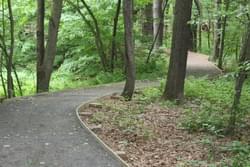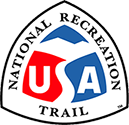




Article by the US Fish and Wildlife Service
The one-mile trail provides a chance to enjoy the natural world at Silvio O. Conte National Fish and Wildlife Refuge.


Designated in 2018
• View more details for this trail
in the NRT Database
• Learn about the NRT Program.
The Fort River Birding and Nature Trail is a universally accessible trail that provides equal access and equal opportunities for all people to spend quality time outdoors and enjoy the natural world. The trail functions as an “outdoor visitor center”, connecting people to nature by immersing them in diverse habitats from grasslands, riparian areas and upland forests. The trail is located in the midst of a lively “Five College Consortium”, and is used as an educational and experiential learning platform for students at all levels of learning. At the same time the trail is frequented by senior citizens and those with mobility challenges, who enjoy the tranquility of the outdoors.
The Fort River Birding and Nature Trail is a multi-functioning, universally accessible trail that provides quality access to all, meeting Architectural Barriers Act (ABA) Accessibility standards and supporting the intent of the National Wildlife Refuge System Improvement Act of 1997, and the Silvio O. Conte NFWR Act of 1991. Located in Western Massachusetts, the trail is intended to be used as an “outdoor visitor center” and an outdoor classroom for both guided and self-guided educational experiences.
The trail was laid out and designed by Refuge employees in 2011/2012, with construction beginning in 2013. Construction of the trail is an example of teamwork at its best. Youth Conservation Corps, Student Conservation Association Interns, community volunteers of all ages and abilities, Boys and Girl Scout Troops and Northeast Region Service employees all played a role in building or laying out a bulk of the trail construction. The trail is designed with lots of curves throughout the habitats to keep the visitor wondering what might be around the next bend. We built the trail bends using gravel, stone dust, and trail ties to retain the flexible pressure treated wood at a five foot width. For the tougher bends, it was necessary to soak the wood overnight to increase their flexibility.
The project was an important learning experience for many of the young people involved, who were being trained to use many of the tools for the first time. Today, we still use members from these groups to help maintain the trail, the surrounding habitat and provide educational programs.
In 2014 the trail was presented with the Paul Winske Access Award by the Stavros Center for Independent Living. The fully accessible trail fills a niche that meets ABA guidelines for outdoor developed areas on Federal lands, and provides opportunities for families with strollers, groups of young children, and an aging population to enjoy the outdoors.
Specific examples of accessible accommodations are the low, flat grade of the trail, the easily passable boardwalk and trail materials, benches placed along the trail (at 50 to 150 yard intervals) for visitors to rest, two covered overlooks to protect visitors from sun or rain, mile markers at each tenth of mile to help orient visitors and navigate the trail, and a two-inch continuous wooden edge on the trail sides to help guide the visually impaired and those in wheelchairs. An accessible restroom is located in the parking lot to accommodate visitors’ needs.
The aesthetic value of the trail is also a highlighted feature. The trail is designed for “clockwise” travel, meandering through a variety of successional habitats from grassland and shrubland, to lowland floodplain, and upland forested areas. It is designed to resemble a ribbon as it passes through these diverse habitats, enhancing the visitor’s experience. The winding of the trail allows visitors to continually see nature in front of them, while also creating a curiosity about what’s beyond the next bend. Several of the trail walkways were specifically designed to allow the passage of the state listed wood turtle, and other small animals that need access to critical habitat.
One overlook on the trail presents a view of the Holyoke Mountain Range, which is one of only two east to west mountain ranges on the entire east coast. The location of this overlook affords visitors beautiful vistas, with opportunities for wildlife observation, photography, and artwork. As with this overlook, all the trail overlooks provide visitors an opportunity to be immersed in nature, with the solitude to engage their senses in an outdoor setting.
Besides being accessible for people, the trail design means it is also “accessible” for wildlife. Small animal “escape hatches” were placed at frequent intervals along the lipped edge to allow toads, snakes and turtles to escape the path and avoid predators. The design of the trail also places it on top of the ground, using a combination of wooden pads rather than digging holes in the ground. The purpose of this design is to preserve Native American artifacts that may be hidden beneath the soil.
The Fort River Birding and Nature Trail is used by a diverse group of
community members for a variety of reasons. Through the Urban Refuge
Partnership with Springfield, Massachusetts, students from Springfield
schools take field trips to the trail for outdoor educational
experiences. The U.S. Fish and Wildlife Service also has a national
partnership with Girls, Inc. providing programs on the trail for Girls,
Inc, of Holyoke during the summer months.
A Friends group has developed in support of the trail and the
Division, to help with offering interpretive and educational programs to
the public, habitat improvements around the trail, and maintenance of
the trail. This trail has sparked an interest in the outdoors for some
community members and engaged them to help maintain and protect open
spaces and the wildlife that inhabit them.
Since its official opening in October 2014, use of the trail has
steadily increased with an estimated visitation of 20,000 a year, and
growing. We continue to maintain the accessible integrity of the trail,
as well as manage the habitats surrounding the trail for quality
wildlife viewing and outdoor recreation experiences.
The Refuge is in the process of finalizing its 15 year Comprehensive
Conservation Plan, which calls for cooperation with communities, school
systems, public and non-profit organizations, and private educational
organizations to facilitate and develop quality environmental education
curricula, as well as to train individuals to conduct quality
environmental education. Refuge managers are in the process of designing
and installing "Storybook" interpretive panels along the trail that
will provide an interactive and educational activity for visitors.